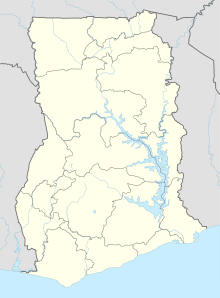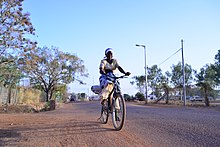Navrongo
Coordinates: 10 ° 53 ′ N , 1 ° 5 ′ W
Navrongo is a city in Ghana and the capital of the Kassena-Nankana District in the Upper East Region . In 2010 the city had a population of 29,993 people.
Navrongo is a very important trading place in the regional area, where a large market is held.
Navrongo is located in northern Ghana on the border with Burkina Faso , which runs about twelve kilometers to the north , in a flat area in the savannah , a dry grassy landscape that is typical of northern Ghana. To the west of the city is the Tono reservoir, and there is an airport about five kilometers to the north.
population
The population of Navrongo is mainly composed of Frafra speakers and Kassena with the Kasem language . Also Dagbani is spoken in Navrongo. The population is made up of roughly equal parts from Frafra and Kassena.
About a third of the population can be assigned to Christianity, although Ghana's north is usually dominated by Islam. In Navrongo, only about 5 percent of the population is attributed to Islam. The followers of the traditional religion still make up the majority of the population.
history
Originally the Gurunsi ruled in Navrongo. According to oral tradition, the Gurunsi are said to come from western Sudan and have crossed the Sahel zone. It was not until around 1500 that the Gurunsi appear in the stories of the Mossi who invaded the north of present-day Ghana at that time to found and expand the Mossi kingdoms. The Gurunsi are said to have fought with the Mossi for supremacy and populated the area around Zecco in Burkina Faso.
According to the founding story, Navrongo is said to be related to the travels of three brothers. Butto (the oldest), Zakato and Sule (the youngest) from the Frafra people are said to have looked for new and better hunting grounds when they came from Zecco. After a few days they came to a small village called Telania in the northeast of today's Navrongo. In Telania the people are said to have belonged to the Kassena people from Tielebe in Burkina Faso (20 miles north of the village), which could explain the spread of the two languages in Navrongo to this day.
The brothers are said to have made friends with the village population and stayed for a while to learn from each other. The brothers taught their architectural techniques, the villagers showed the brothers their agricultural knowledge. One day Butto was said to have been hunting in the area when he found soft ground. When he got to the village he told his brothers about his discovery. He called the place Na-Voro (Naga (foot) and Voro (soft)). Na-Voro is still the name of the town in use today. Navrongo only became known as an English translation and thus entered common usage.
Butto has returned to the spot he found, believed to be about a quarter of a mile from the town's Notre Dame Secondary School. To this day, a building can be seen that is said to be identical to this foundation building. The brothers Zakato and Sule initially stayed in the village of Telania. Butto is said to have found a grove of trees and stones on another hunt, which reminded him of his traditional shrine in Zecco. This memory of his religious roots is said to have moved Butto to change his location again and to move closer to the place that reminded him of his old holy place. This place is said to be where the tribal chiefs of Navrongo have their headquarters today.
The city is said to have been founded in 1740.
In the following period slave hunters roamed the country. One of them was Babatu Zato (1850? -?) Who let the villages hand over high taxes to cattle and horses in order to spare the inhabitants. In 1896, French troops led by Lieutenant Voulet and Lieutenant Chanoine arrived at the area at the instigation of a Gurunsi leader, Hamaria. As a result, the slave hunter fled south to the Wa area .
In 1901 a British expedition camped about 10 miles south of Navrogno near the village of Vanania. The local population mistook the troops for the henchmen of the slave hunter Babatu, who is also said to have light skin. Because of his fair skin, the population called him Fela , which means Kasem Weißer in the language . The then chief in Navrongo, Kwara, had the drums beat to warn the surrounding area of Fela , who was camped on a hill near Vanania called Tinu . A small group of warriors attacked the campers, but had to give up the attack after a short time due to the superior armament of the actual British troops.
The protection force of the British expedition came near Kwara's house in Navrongo and offered the chief protection from the slave hunter, which the chief is said to have accepted. This act is said to have strengthened the position of the chief in the village and suppressed the influence of the spiritual leader Tegetu , who was important until then , but who is still an authority in the area today. The British stayed in Navrongo with one force.
Another version reports the establishment of a British military base in Navrongo with the note that the city was civilized "by force of arms" in order to resolve an ethnic conflict. A chief who served the interests of the British was appointed by them and free labor , i.e. the unpaid work of the residents of the place, was used by the British to build roads and administrative buildings. Some residents of Navrongo are said to have been sent by the British to build the railway line or to the mines in the south of the country.
As a trading post on the trade routes through the Sahel region, Navrongo became an important stopover for watering the caravans' camels. Even today it is not uncommon for camels to come to the city to water.
On April 23, 1906, the Catholic priests (Canadian / French) Morin and Chollet as well as the monk Brother Eugene came to the British military base in Navrongo to establish a Catholic mission. This group of missionaries is said to have come from Ouagadougou in Burkina Faso and made the journey on foot. In June 1906 a small hut was built, which was replaced a little later by a house with a solid roof, windows and doors. In 1920 a chapel was built, which has been called the cathedral since 1934 . Navrongo Cathedral is the main church of the Catholic communities in Northern Ghana, which are part of the Navrongo-Bolgatanga diocese . The British are said to have tolerated the use of the French missionaries on the condition that English was taught in the mission school. The mission school has gained a good reputation after initial difficulties.
With Ghana's independence in 1957, Navrongo became the capital of the Kassena-Nankana District .
economy
Economically, almost all residents of Navrongo depend on agriculture. Agriculture is little dependent on machines, but is mainly done by hand. The entire area around Navrongo is very rural. Mainly millet, peanuts and corn are grown. The keeping of cattle, sheep and goats is also an important economic factor in the life of the people of Navrongo.
The market in Navrongo plays a major role as a source of income and is of regional importance.
In Sirigu in northeastern Navrongo, an organization of around 150 women has been formed to promote the manufacture of pottery, the Sirigu Women Organization of Pottery and Art (SWOPA) . Besides the task of preserving the traditional arts and training them in them, the women of the organization have created a source of income in the field of tourism by selling their pottery. Members were also involved in the redecoration of Navrongo Cathedral.
architecture
The architecture in Navrongo is particularly worth seeing. There is a wide range of variations in shape, size and use. Often the outer walls are traditionally painted or provided with a relief. The door frames are usually designed in a particularly artistic way. The traditional colors are natural colors made from surrounding materials and essentially consist of black, red and white.
The Catholic Cathedral of Navrongo was initially built as a simple barrack on the British military base in Navrongo and only became a cathedral in 1934, after it had been expanded as a permanent building in 1920. The cathedral was built by the founders of Our Lady of Seven Sorrows ( Seven Sorrows called). The walls are made of clay, which is why the building is also called Mud Cathedral . The roof is a wooden structure. The interior of the cathedral, which is 60 meters long and 14 meters wide, is richly decorated with images of animals and everyday scenes. Christian themes can also be found in the pictures; the Bethlehem scene and the depiction of the Last Supper flank the entrance area. The building has a 13 meter high church tower on the front and a large nave under pillars inside . The walls were hardened from a mixture of clay , cow dung and the fruit extract of the Dawa-Dawa tree, which is often found in the region, and thus received a waterproof plaster.
The cathedral has been on the tentative list of UNESCO World Heritage in Ghana since 2000 .
education
Navrongo is home to a campus of the University for Development Studies at the Faculty of Applied Sciences.
Web links
- Navrongo Health Research Center - Ghana Health Service research center, engl.
Footnotes
- ↑ Ghana Statistical Service: 2010 Population & Housing Census, p. 78 ( Memento of the original from February 18, 2018 in the Internet Archive ) Info: The archive link was inserted automatically and has not yet been checked. Please check the original and archive link according to the instructions and then remove this notice. (English) , accessed January 30, 2018
- ↑ St. John-Parsons, Donald. Legends of Northern Ghana
- ↑ Adewoba. 'Aspects of Wealth and Exchange'
- ↑ Arhim. 'The Papers of George Ferguson'
- ↑ SWOPA ( Memento of the original dated February 7, 2007 in the Internet Archive ) Info: The archive link was inserted automatically and has not yet been checked. Please check the original and archive link according to the instructions and then remove this notice.
- ^ Architecture in Navrongo, Photos, engl. ( Memento of the original dated February 8, 2007 in the Internet Archive ) Info: The archive link was inserted automatically and has not yet been checked. Please check the original and archive link according to the instructions and then remove this notice.
- ↑ Tentative list World Heritage Ghana - Navrongo Cathedral ( English ), accessed on January 30, 2018




